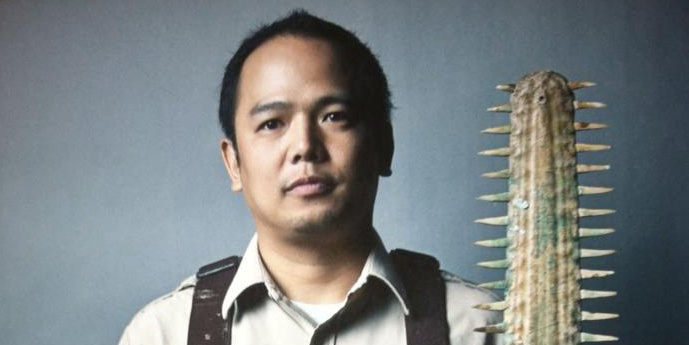Francis Mendoza
Exploring Nature
Teaching Credential '99

The East Bay is home to several regional parks that each offer something distinctly unique. Francis Mendoza ('99) is a naturalist with the East Bay Regional Parks District. He educates folks of all backgrounds on the natural and cultural history of our parks, shorelines and open spaces. He uses the education received at Cal State East Bay to teach folks about the science of nature, indigenous ways and diversity. Read his full interview to learn about his top ten favorite East Bay Regional Parks.
Q&A with Francis
Why did you decide to attend Cal State East Bay?
When I graduated from UC Berkeley with a Biology major and Education minor, I was looking for teaching credential programs that emphasized working in marginalized communities like Hayward, San Lorenzo and my hometown, Union City. I've lived in all those cities and wanted to teach in a high school that provides a rigorous, culturally relevant curriculum to its student body. I chose Cal State Hayward because they had a highly competitive internship program within my former high school, James Logan High.
How has your education at East Bay helped you with your endeavors?
The Teaching Credential program taught me how to teach effectively within a diverse community such as the east bay. As a park ranger and naturalist, I continue to employ the pedagogy and methodologies I learned at Cal State in my work.
Tell us a little about yourself and your role as a Naturalist for Coyote Hills.
As a Naturalist with the East Bay Regional Park District, I educate folks of all backgrounds on the natural and cultural history of our parks, shorelines and open spaces. I received my Science Teaching Credential from Cal State Hayward and use it to teach folks about the science of nature, indigenous ways and diversity.What are your top 10 favorite East Bay Regional Parks? Why?
In no particular order:- Coyote Hills; I run, bird, bike and watch sunsets here often and am lucky enough to call it my home park. It's also a place where Tuibun Ohlone have called home since time immemorial.
- Garin/ Dry Creek Pioneer; Long, meandering trails you could get lost in without seeing houses or roads. It is a truly historic park which served as a home for a Ukrainian civil rights leader, the Meyers sisters who helped protect their land from development, and a rich farming history with an historic barn.
- Hayward Regional Shoreline; a dozen miles of flat, easy trails accesible to all people along the beautiful east bay shoreline with an Interpretive Center to educate people on its many features.
- Sunol Regional Wilderness; miles of trails that harken back to a time where indigenous peoples were the sole caretakers of the land and reminds us that they are still here honoring their ancestors' ways.
- Morgan Territory; huge valley oaks and manzanitas line the trails here, and the trail-running here is magnificent.
- Huckleberry Botanic Preserve; a small park with plenty of its namesake plant, along with rare plants that are endemic to this area and singletrack trails that you can make a quick run out of.
- Vasco Caves; only accessible by Naturalist-led tours, Vasco is a series of windswept caves with vernal pools, endangered species such as Tiger Salamanders, and Indigenous rock art.
- Keller Beack at Miller Knox; a beautiful, protected beach with eelgrass habitat for native flora and fauna such as pipefish and oysters; a beautiful place to watch the sun set over San Francisco and Marin.
- Brooks Island; only accessible by Naturalist-led boat tours, Brooks is an island in the middle of the Richmond Harbor that is habitat for rare butterflies, plants and lichen.
- Reinhardt Redwood; a gorgeous second-growth redwood forest that offers trails for running, trees that literally give us life and regeneration, and are emblematic of the resilience many of our marginalized communities have to endure pandemics and systemic racism.
What are some things people should keep in mind when visiting East Bay Regional Parks?
As more and more of our parks reopen, please continue to stay socially distanced, wear masks and enjoy your parks in a responsible way. As we #recreateresponsibly, let's make sure we're not feeding wildlife, keeping our dogs well-behaved and/or leashed, and heading elsewhere if you roll up to one of our parks and find it full or incredibly busy.Are there any virtual resources people can access to learn more about the park they are visiting?
Our staff have been hard at work providing education, access and safety to those who want to enjoy the parks virtually. Visit www.ebparks.org/dl for digital learning resources, as well as Facebook, Instagram, YouTube and Twitter, which we have @EBRPD accounts for. For educators, we have a long list of free, downloadable resources including an Ohlone curriculum that teaches students the importance of native land in our parks. For hikers, we have a free Trails Challenge program that encourages folks to try out hikes in any of our 73 parks throughout the year and receive a guidebook, t-shirt and pin (while supplies last). All of these programs can be accessed at www.ebparks.org.
What is your fondest memory of CSUEB?
My fondest memories of going to school at Cal State Hayward involved studying late at night in the library or in "the Cave" within the Science Building. Studying with friends is the best way to learn how to become an educator, through helping each other through tutoring and sharing knowledge with one another. Late night food runs and coffee breaks helped, too.
If you can share one piece of advice with Pioneer students, what would that be?
Be an active member of your community, whether you're a graduate student looking to get into a professor's lab, or an undergrad looking to work with non-profits and community-based organizations to help round out your academic education with an experiential one.